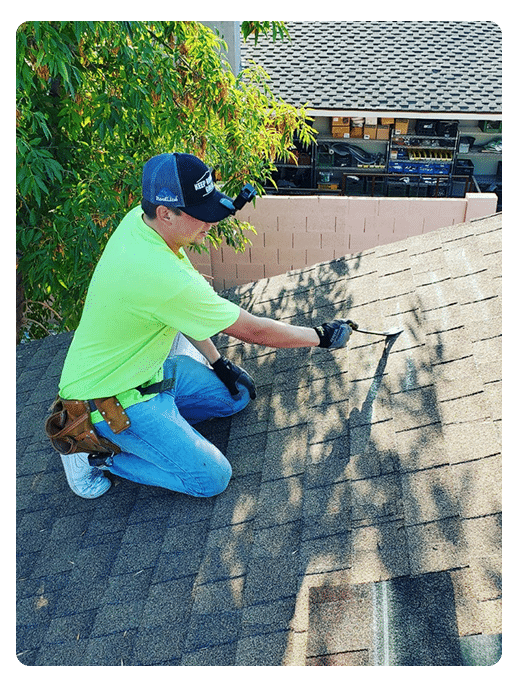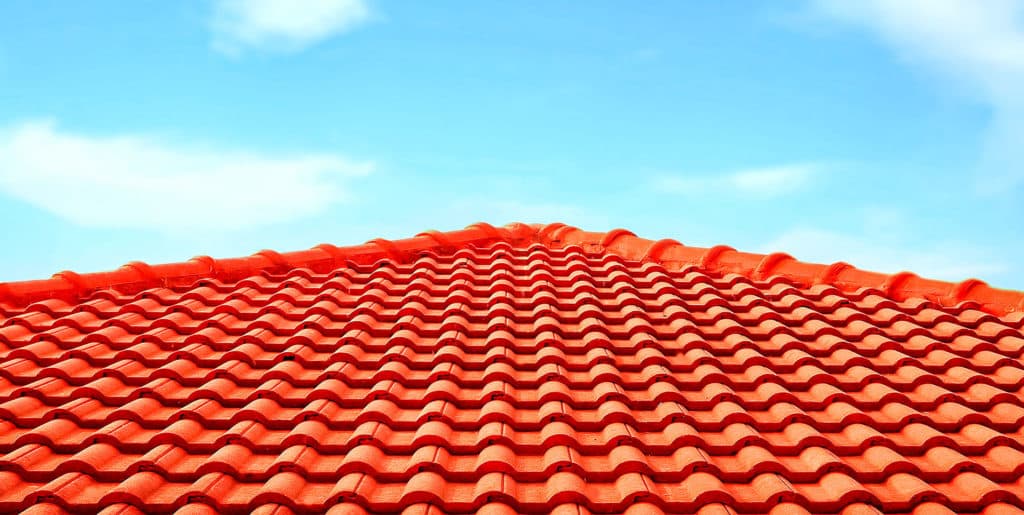Arizona is known for its hot, often arid climate and unpredictable weather. As such, it comes as no surprise that roof damage in the region is a common occurrence.
Roofs are an integral part of any home or commercial building, providing protection from harsh elements while ensuring structural integrity. The first step towards avoiding costly repairs due to roof damage is understanding what causes it in the first place.
Heat waves can cause shingles to become brittle and compromise their protective coating; strong winds can strip off those same weakened shingles; hail storms can create dents or punctures; snowfall can pile up on flat roofs and weaken support structures – all these factors contribute significantly to the wear-and-tear process that eventually leads to extensive repairs being necessary.
By taking simple preventative measures ahead of time, homeowners and business owners alike may be able to save themselves both time and money in the long run.
Heat Damage
Heat damage is one of the most common causes of roof damage in Arizona. The summer temperatures can reach as high as 117 degrees Fahrenheit, and these extreme conditions cause materials such as shingles to deteriorate over time. This deterioration leads to cracks and splits that allow moisture into the home, leading to water damage or even mold growth.
In addition, extremely hot temperatures are often accompanied by strong winds which can rip apart weakly attached components like flashing or sealants, resulting in further damage. To avoid heat-related roof damage it’s essential to use durable material designed for arid climates. Roofers should also regularly inspect a home’s ventilation system to ensure proper air flow throughout the attic space, and be sure all exposed areas receive adequate protection from UV rays with weatherproof coatings when applicable.

Additionally, regular maintenance on gutters and downspouts will help keep debris away from vulnerable areas of the roof while providing an additional layer of insulation against excess heat build up.
Wind Damage
Wind damage is a common cause of roof damage in Arizona. High winds associated with monsoon season can tear off shingles, loosen nails, and even remove entire sections of the roof covering. Wind-driven debris such as tree branches or flying objects like trash cans can also impact roofs greatly and often result in expensive repairs.
Homeowners should take preventative measures to avoid wind damage before it becomes an issue. First, homeowners must ensure that their roofs are up to local building codes and standards for wind resistance. This means having adequate fasteners and proper materials to withstand extreme wind pressures from storms.
Additionally, all parts of the roof—including chimneys, skylights, vents, etc.—should be securely sealed against any potential water intrusion during heavy rains. Finally, trimming back trees near the home can help minimize the risk posed by falling limbs during strong winds.
Hail Damage
Hail damage is one of the most common causes of roof damage in Arizona. As hailstorms are a frequent occurrence here, it can be expected that roofs will suffer from hail-related issues if not properly maintained.
In order to avoid such situations, homeowners should take certain preventive measures like ensuring that their roofs have been recently inspected and maintained by licensed professionals, replacing any missing or damaged materials on their roofs, and installing an impact-resistant layer below the shingles for added protection against hail. Additionally, they may also consider investing in storm shutters as these can help protect windows and doors from hail damage during storms.
Regular maintenance of gutters and downspouts is also essential since clogged drains can cause water build up which can lead to further damages caused by heavy rains or snowfall. Homeowners should ensure that all drainage systems are regularly checked so that any blockages due to fallen leaves or debris are cleared away before causing problems with water runoff.
Furthermore, trimming back overhanging branches is important as this prevents them from breaking off in strong winds and damaging a home’s roof surface during storms. Taking these steps helps reduce the chances of sustaining serious damage caused by hailstorms or other natural disasters in the future.
Snow Damage
Snow damage is another common cause of roof damage in Arizona. Snowfall can be especially damaging when it accumulates on the rooftops, as its weight and melting may lead to structural problems that could result in significant repair costs.
Furthermore, snow left on the rooftop for too long can also create leaks from clogged gutters or broken shingles. To help prevent such issues, homeowners must ensure their roofs are regularly inspected and maintained by a professional contractor who knows how to identify potential weaknesses before they become serious problems.
Additionally, roofers should ensure proper ventilation systems are installed which will allow any accumulated snow to quickly melt away and reduce the risk of water-related damages.
Leaks
Roof leaks are one of the most common causes of roof damage in Arizona. They can be caused by extreme weather conditions, such as heavy rain and wind, or even a lack of regular maintenance.
Leaks can occur anywhere on the roof that is not properly sealed or insulated, and they can cause significant amounts of water to seep into the home causing further damage and potential mold growth.
To avoid costly repairs due to leaking roofs it is important to have regular inspections done on your roofing system and make any necessary repairs immediately after they are identified. Additionally, ensuring proper ventilation within the attic area will help reduce condensation build-up which could lead to eventual leaks if left unchecked.
Improper Ventilation
It is essential to ensure that roofs in Arizona are properly ventilated. Without proper ventilation, heat can become trapped between the roof and insulation and cause damage over time.
Furthermore, hot air rising from within a home or building can be blocked by an improperly vented roof, leading to more wear and tear on the structure due to excessive condensation.
The best way to avoid these problems is to make sure that there is adequate airflow under your roof decking. This means having equal amounts of soffit and ridge vents installed throughout the attic space.
It’s also important to use high-quality materials when constructing your vents, such as metal rather than plastic, since they will be exposed directly to sunlight and other elements.
Additionally, keep any trees or shrubs around the perimeter of your house trimmed back regularly so they don’t block air flow into your attic space.
Taking these steps will help you maintain a healthy ventilation system for years to come, protecting your roof from potential damage caused by improper ventilation.

Poor Maintenance Practices
Poor maintenance practices can be one of the most common causes of roof damage in Arizona. Homeowners must take a proactive approach to properly maintain their roofs, as failure to do so can result in costly repairs or even complete roof replacement down the road.
Regularly inspecting and cleaning gutters and drains is essential for avoiding damages from storms, flooding and debris accumulation. Additionally, regularly checking the flashing around chimneys, skylights, walls and other areas where two surfaces meet should be done to prevent water intrusion.
Identifying potential problems early on can help catch small issues before they become large ones that require extensive repair work. By being vigilant about proper maintenance, homeowners can save themselves time and money while ensuring their home’s protection against weather elements.
Taking these steps now will make for peace of mind later when severe weather strikes Arizona’s harsh climate.
Conclusion
In conclusion, roofs in Arizona are exposed to a number of environmental conditions that can cause damage.
Heat, wind, hail, snow and improper ventilation can all contribute to roof damage if not managed properly.
Leaks and poor maintenance practices may also lead to further deterioration over time.
The best way to avoid such issues is by regularly inspecting the roof for signs of wear and tear, as well as having an experienced professional perform regular maintenance checks.
By following these steps, homeowners can ensure their roof remains structurally sound and safe from potential damages caused by Arizona’s environment.


